unit5 Do you like pears全英说课稿
人教版(PEP)三下《Unit5Doyoulikepears》(第2课时)说课稿

人教版(PEP)三下《Unit 5 Do you like pears》(第2课时)说课稿一. 教材分析《Unit 5 Do you like pears》是人教版(PEP)三下册的一篇课文,主要讲述了水果的喜好。
本节课文内容丰富,贴近生活,适合激发学生学习英语的兴趣。
通过本节课的学习,学生能够掌握关于水果的词汇,以及询问和描述水果喜好的句型。
二. 学情分析三下年级的学生已经具备了一定的英语基础,对于基本的日常对话和简单句型的表达已经没有问题。
但学生在语言运用方面还存在一定困难,如单词的发音、词汇的积累以及句型的运用。
因此,在教学过程中,需要注重学生的语言实践和兴趣培养。
三. 说教学目标1.知识目标:学生能够掌握关于水果的词汇,如pear, orange, banana等;能够运用句型“Do you like…?”和“Yes, I do./No, I don’t.”来询问和描述水果喜好。
2.能力目标:学生能够在日常生活中运用所学词汇和句型进行简单的交流。
3.情感目标:培养学生热爱生活,关注健康的意识。
四. 说教学重难点1.重点:掌握关于水果的词汇和句型“Do you like…?”和“Yes, I do./No, Idon’t.”2.难点:单词的发音和词汇的积累,以及句型的运用。
五. 说教学方法与手段1.采用情境教学法,通过设定真实的生活情境,让学生在实际语境中学习和运用英语。
2.运用任务型教学法,引导学生参与各种实践活动,提高学生的语言运用能力。
3.利用多媒体教学手段,如图片、视频等,丰富教学内容,激发学生学习兴趣。
六. 说教学过程1.热身(5分钟):引导学生唱英文歌曲“Old MacDonald Had a Farm”,激发学生学习兴趣。
2.引入(10分钟):展示水果图片,引导学生用中文说出水果名称,然后过渡到英文。
3.呈现(10分钟):教师出示单词卡片,引导学生朗读并记忆水果词汇。
4.实践(15分钟):学生分组进行角色扮演,运用所学句型进行对话。
doyoulikepears说课稿全英文

doyoulikepears说课稿全英文"Do You Like Pears" Lesson PlanI Teaching Objectives1、 Language skillsStudents will be able to understand and use the sentence pattern "Do you like?" and answer it with "Yes, I do" or "No, I don't" Students will be able to recognize and pronounce the words "pear","apple","banana", and "orange" correctly2、 Knowledge objectivesStudents will understand the meaning of the words related to fruitsStudents will know how to express their likes and dislikes about fruits3、 Emotional objectivesTo cultivate students' interest in learning EnglishTo encourage students to have a balanced diet and develop good eating habitsII Teaching Key Points1、 The key vocabulary: pear, apple, banana, orange2、 The target language: Do you like? Yes, I do / No, I don'tIII Teaching Difficult Points1、 How to help students use the sentence pattern accurately and fluently in real situations2、 How to make students pronounce the words correctly, especially the vowelsIV Teaching Methods1、 Taskbased Language Teaching Method2、 Communicative Language Teaching Method3、 Situational Teaching MethodV Teaching Aids1、 Multimedia courseware2、 Pictures of fruits3、 Word cardsVI Teaching ProceduresStep 1: Warmup (5 minutes)1、 GreetingsSay hello to the students and ask them how they are today2、 Sing a songPlay the song "Fruit Song" and encourage students to sing alongStep 2: Presentation (15 minutes)1、 Show picturesShow pictures of different fruits, such as pears, apples, bananas, and orangesAsk students to name the fruits in Chinese2、 Teach new wordsPresent the English words for the fruits one by oneUse gestures and repetition to help students remember the pronunciation and spellingFor example, when teaching "pear", hold up a pear picture and say "pear, pear, this is a pear"3、 Sentence pattern introductionAsk a student "Do you like pears?" and guide them to answer "Yes, I do" or "No, I don't"Repeat this with several students and different fruitsStep 3: Practice (15 minutes)1、 Group workDivide students into groups of fourGive each group some pictures of fruits and word cardsAsk them to practice the dialogue "Do you like? Yes, I do / No, I don't" using the pictures and words2、 Game: Fruit BasketPrepare a basket with some fruitsChoose a student to come to the front and pick a fruit from the basketThe other students ask "Do you like?" and the student answers Step 4: Production (10 minutes)1、 Make a surveyAsk students to do a survey in the class They need to ask their classmates about their likes and dislikes of fruits and fill in the tableAfter the survey, ask some students to report their findings2、 RoleplayPresent a situation: You are in a fruit shop You and your friend are buying fruitsAsk students to roleplay the dialogue in pairsStep 5: Summary and Homework (5 minutes)1、 SummaryReview the key words and sentence patterns learned in this lessonEncourage students to eat more fruits to keep healthy2、 HomeworkAsk students to draw their favorite fruit and write the English name belowAsk students to practice the dialogue with their parentsVII Blackboard DesignOn the left side of the blackboard, write the new words: pear, apple, banana, orangeOn the right side, write the sentence pattern: Do you like? Yes, I do /No, I don'tVIII Teaching ReflectionIn this lesson, students showed great interest in learning about fruits and the target language The activities and games helped them practice and consolidate the knowledge However, some students still had difficulty in pronouncing the words accurately, and more individual guidance is needed in the future Also, in the production part, some students were not very active in expressing themselves More encouragement and support should be given to help them build confidenceThis lesson plan aims to provide a lively and effective English learning experience for students, helping them master the language skills related to fruits and expressing likes and dislikes Through various teaching methods and activities, students can actively participate in the class and improve their language proficiency。
Unit 5 Do you like pears?Part B Let's Learn(说课稿)-2
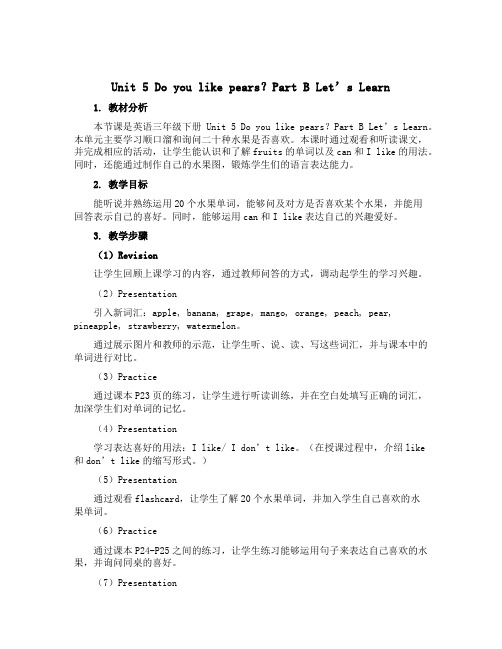
Unit 5 Do you like pears?Part B Let’s Learn1. 教材分析本节课是英语三年级下册Unit 5 Do you like pears?Part B Let’s Learn。
本单元主要学习顺口溜和询问二十种水果是否喜欢。
本课时通过观看和听读课文,并完成相应的活动,让学生能认识和了解fruits的单词以及can和I like的用法。
同时,还能通过制作自己的水果图,锻炼学生们的语言表达能力。
2. 教学目标能听说并熟练运用20个水果单词,能够问及对方是否喜欢某个水果,并能用回答表示自己的喜好。
同时,能够运用can和I like表达自己的兴趣爱好。
3. 教学步骤(1)Revision让学生回顾上课学习的内容,通过教师问答的方式,调动起学生的学习兴趣。
(2)Presentation引入新词汇:apple, banana, grape, mango, orange, peach, pear, pineapple, strawberry, watermelon。
通过展示图片和教师的示范,让学生听、说、读、写这些词汇,并与课本中的单词进行对比。
(3)Practice通过课本P23页的练习,让学生进行听读训练,并在空白处填写正确的词汇,加深学生们对单词的记忆。
(4)Presentation学习表达喜好的用法:I like/ I don’t like。
(在授课过程中,介绍like和don’t like的缩写形式。
)(5)Presentation通过观看flashcard,让学生了解20个水果单词,并加入学生自己喜欢的水果单词。
(6)Practice通过课本P24-P25之间的练习,让学生练习能够运用句子来表达自己喜欢的水果,并询问同桌的喜好。
(7)Presentation通过观看动画及完成填空,引入can和问句“Can you eat…?”的用法。
(8)Practice通过课本P25页的小游戏,让学生应用所学知识,知晓有哪些水果不能吃,做到生动有趣,引导学生学以致用。
Unit 5 Do you like pears PA let's talk(公开课) 说课稿

Unit 5 Do you like pears PA let’s talk(公开课)说课稿一、教材分析本单元教材为《PEP小学英语》三年级下册Unit 5,本课时为Do you like pears? Let’s talk. 本单元紧扣“我喜欢吃水果”这一主题,课文内容为小朋友们分享自己喜欢吃的水果,并向别人询问其喜欢的水果种类,进一步学习了解了解水果的名称、颜色和口味。
二、教学目标1.学会询问别人喜欢的水果种类,并仔细聆听对方的回答;2.能够使用英文表达自己喜欢吃的水果种类;3.熟练掌握新单词Apple, banana, pear, orange, watermelon, grape;4.通过与小组成员互动交流,提高英语口语表达能力;5.学习了解水果的外形、颜色和口感。
三、教学重点难点1.教学重点:询问别人喜欢的水果种类,并积极聆听对方的回答;2.教学难点:学生自我介绍,表达自己的水果喜好,发挥个人英语口语表达能力。
四、教学步骤Step1:导入老师用图片卡片出示苹果、香蕉、梨、橙、西瓜和葡萄等水果图片,帮助学生巩固认知。
Step 2:口语练习老师与学生进行提问互动,熟练掌握课文中所出现的6个水果单词。
1.Teacher: Do you like apples?Student: Yes, I do. / No, I don’t.2.Teacher: What about bananas?Student: Yes, I like bananas. / No, I don’t like bananas.3.Teacher: How about pears?Student: Yes, I like pears. / No, I don’t like pears.4.Teacher: What’s your favorite fruit?Student: My favorite fruit is oranges.Step 3:小组对话学生进行小组活动,积极提问组内伙伴的水果喜好,并记录小组成员回答到的信息,进一步提高学生的口语表达能力。
unit5Doyoulikepears全英说课稿
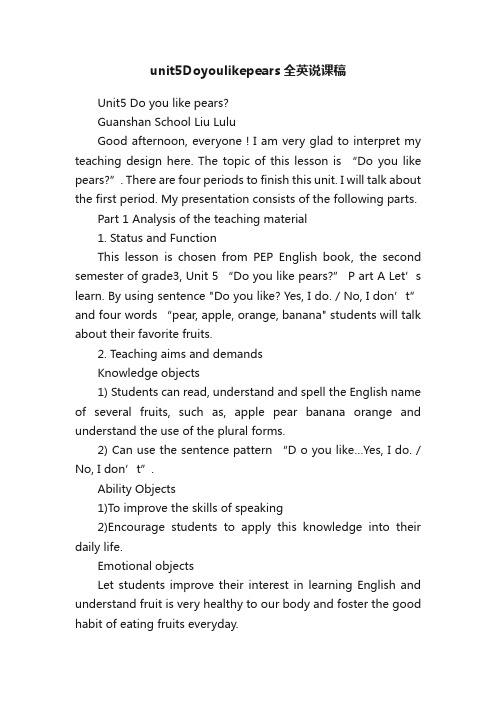
unit5Doyoulikepears全英说课稿Unit5 Do you like pears?Guanshan School Liu LuluGood afternoon, everyone!I am very glad to interpret my teaching design here. The topic of this lesson is “Do you like pears?”. There are four periods to finish this unit. I will talk about the first period. My presentation consists of the following parts.Part 1 Analysis of the teaching material1. Status and FunctionThis lesson is chosen from PEP English book, the second semester of grade3, Unit 5 “Do you like pears?” P art A Let’s learn. By using sentence "Do you like? Yes, I do. / No, I don’t” and four words “pear, apple, orange, banana" students will talk about their favorite fruits.2. Teaching aims and demandsKnowledge objects1) Students can read, understand and spell the English name of several fruits, such as, apple pear banana orange and understand the use of the plural forms.2) Can use the sentence pattern “D o you like…Yes, I do. / No, I don’t”.Ability Objects1)To improve the skills of speaking2)Encourage students to apply this knowledge into their daily life.Emotional objectsLet students improve their interest in learning English and understand fruit is very healthy to our body and foster the good habit of eating fruits everyday.3. Key points and DifficultyKey points: words—apple banana pear orangesentence structure —Do you like…Yes, I do. / No, I don’t Difficulty: understand the use of the plural formsPart 2 Analysis of the students.The students have just learnt English for a semester, so some of them don’t have many good learning methods. Some students dare not use English to express themselves. But they are curious, active and fond of game competition and various activities. They enjoy learning through cooperation in a relaxing atmosphere.Part 3 Teaching methods and Learning strategiesTeaching methodsIn this lesson, I will use directly method, that is to say, I will teach the key points by showing some pictures.In the process, I will apply blackboard, pictures and multi-media computer to arouse the students’ interestLearning strategies1)Speaking method2)Communicative strategy. Learn to cooperate with others. In class, encourage the students to communicate with others and build up their confidence.Part 4 Teaching AidsBlackboard, pictures, multi-media computerPart 5 Teaching Procedures.There are six steps in my teaching procedures.Step 1 Greeting and Lead-in.1.Make a free talk between T- S.2.Enjoy a radio. (Fruit Song)Purpose: Lead the students into the new lesson smoothlyand arouse the students’ interest.Step 2 Let’s learn1. Presentation of the new words. (Play the PPT)T: Boys and girls, look at the screen. I have an orchard. There are some fruit. What are they?Let’s learn them.(1) Teach pear and pears.T: What’s this? (Show a picture of pear, the students may answer in Chinese. Then I show the word and write it on the blackboard. )T: Now read after me. pear ↗ pear↗ pear↘Ss: pear↗ pear↗ pear↘(Ask several students to read it.)T: Look! Now there are nine pears. pears ↗ pears↗ pears↘(Show a picture of nine pears, and lead students to understand the plural form.)(2) Teach apple 、orange 、 banana (use the same way)Purpose: make students master the four words and understand the use of the plural forms.2. Presentation of the sentence structureT:I like pears. Do you like pears?Yes, I do. / No, I don’t. (Show the sentences to the students and write them on the blackboard. Then lead students to read them. After that ask some st udents “ Do you like…”to practice this sentence pattern. ) Purpose: Let students be familiar with the sentence structure and speak out this structure without any thinking.Step 3 Practice1. Pair workGive students three minutes to use “D o you like…Yes, I do. / No, I don’t”to make a conversation with desk mates. Then I will invite some pairs to share their conversations with otherstudents.Purpose: Develop students’ ability of communication and cooperation. By using the target language to consolidate the key structure and improve their speaking skills.2. Let’s play games1) What’s missing? (Make one kind of fruit missed quickly and ask students to speak out this fru it’s name quickly.) 2)Guess!a. What’s this?b. RiddlesPurpose: Mobilize students' enthusiasm and initiative, in the same time, consolidate the key words.Step 4 Summary1. Summarize the words and the sentence structure.T: Look at the picture in the book, listen to the tape and read after the tape.(Play the tape and ask students to read after the tape)Purpose: Strengthen what they’ve learnt in this class.2.Enjoy a radioT: An apple a day keeps the doctor away, that means, eating more fruits can keep you healthy! Let’s eat t he fruits.Purpose: Make students understand fruit is very healthy to our body and foster the good habit of eating fruits everyday.Step 5 HomeworkDraw your favorite fruits and talk about in English.Purpose: Improve their speaking ability.Step 6 blackboard DesignUnit 5 Do you like pears?pear pears apple apples orange oranges banana bananasDo you like pears/ apples/ oranges/ bananas?Yes, I do. No, I don’t。
doyoulikepears说课稿
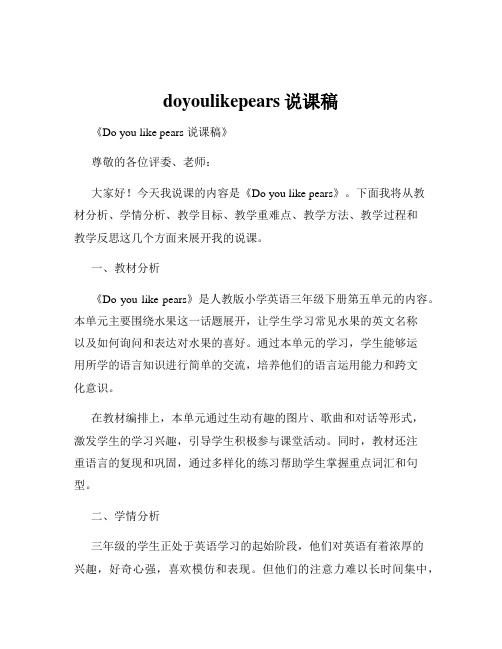
doyoulikepears说课稿《Do you like pears 说课稿》尊敬的各位评委、老师:大家好!今天我说课的内容是《Do you like pears》。
下面我将从教材分析、学情分析、教学目标、教学重难点、教学方法、教学过程和教学反思这几个方面来展开我的说课。
一、教材分析《Do you like pears》是人教版小学英语三年级下册第五单元的内容。
本单元主要围绕水果这一话题展开,让学生学习常见水果的英文名称以及如何询问和表达对水果的喜好。
通过本单元的学习,学生能够运用所学的语言知识进行简单的交流,培养他们的语言运用能力和跨文化意识。
在教材编排上,本单元通过生动有趣的图片、歌曲和对话等形式,激发学生的学习兴趣,引导学生积极参与课堂活动。
同时,教材还注重语言的复现和巩固,通过多样化的练习帮助学生掌握重点词汇和句型。
二、学情分析三年级的学生正处于英语学习的起始阶段,他们对英语有着浓厚的兴趣,好奇心强,喜欢模仿和表现。
但他们的注意力难以长时间集中,词汇量和语言表达能力有限。
因此,在教学过程中,我将采用多样化的教学方法和手段,创设生动有趣的教学情境,激发学生的学习积极性,让他们在轻松愉快的氛围中学习英语。
三、教学目标1、知识目标(1)学生能够听、说、认读单词:pear, apple, orange, banana, grape。
(2)学生能够听懂、会说句型:Do you like? Yes, I do / No, Idon't2、能力目标(1)学生能够运用所学句型询问他人对水果的喜好,并做出相应的回答。
(2)学生能够在实际情境中运用所学单词和句型进行简单的交流。
3、情感目标(1)培养学生学习英语的兴趣,激发他们的学习积极性。
(2)培养学生健康的饮食观念,让他们了解多吃水果对身体有益。
四、教学重难点1、教学重点(1)掌握单词:pear, apple, orange, banana, grape 的发音和拼写。
doyoulikepears说课稿--刘小菁
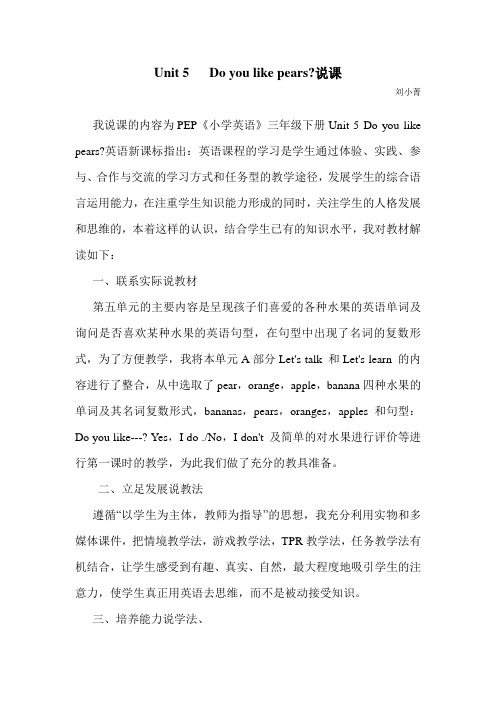
Unit 5 Do you like pears?说课刘小菁我说课的内容为PEP《小学英语》三年级下册Unit 5 Do you like pears?英语新课标指出:英语课程的学习是学生通过体验、实践、参与、合作与交流的学习方式和任务型的教学途径,发展学生的综合语言运用能力,在注重学生知识能力形成的同时,关注学生的人格发展和思维的,本着这样的认识,结合学生已有的知识水平,我对教材解读如下:一、联系实际说教材第五单元的主要内容是呈现孩子们喜爱的各种水果的英语单词及询问是否喜欢某种水果的英语句型,在句型中出现了名词的复数形式,为了方便教学,我将本单元A部分Let's talk 和Let's learn 的内容进行了整合,从中选取了pear,orange,apple,banana四种水果的单词及其名词复数形式,bananas,pears,oranges,apples和句型:Do you like---? Yes,I do ./No,I don't 及简单的对水果进行评价等进行第一课时的教学,为此我们做了充分的教具准备。
二、立足发展说教法遵循“以学生为主体,教师为指导”的思想,我充分利用实物和多媒体课件,把情境教学法,游戏教学法,TPR教学法,任务教学法有机结合,让学生感受到有趣、真实、自然,最大程度地吸引学生的注意力,使学生真正用英语去思维,而不是被动接受知识。
三、培养能力说学法、科学的学习是把开启学生智能的金钥匙,也是学生取得成效的必要条件,在学习本课时,我将引导学生在民主、和谐、兴趣盎然中积极参与学习,主动模仿,保持对所学材料的兴趣和热情,在乐中学,玩中学。
四、情境互动说过程1. Greeting: 师生问候及日常用语对话。
2. Now, look at the ppt. Let’s sing a song. 教师播放英语Apple歌,全班齐唱,学生很快进入到英语课堂中来.3 Game: what’s this?.(T: Now, let’s play game: what is this ? Ss: It’s …..)(出示单词PPT, 让学生看.Step2: Let’s learn1. Presentation of the new words.(1) Teach pear.①Lead in and practice (播放课件)T: Boys and girls, look here. I have some fruits. Let’s learn them.今天老师给同学们带来了一些礼物,我们一起来看一看, 哇! 好多的水果呀! 和老师一起来认识一下吧!(水果评价卡片)T: What’s this ? Who can answer? Please put up you hands.(PPT出示一个水果,师引导学生回答后,出示梨子单词,让生跟读。
Unit 5 Do you like pears? Part A Let's learn(说课稿)-
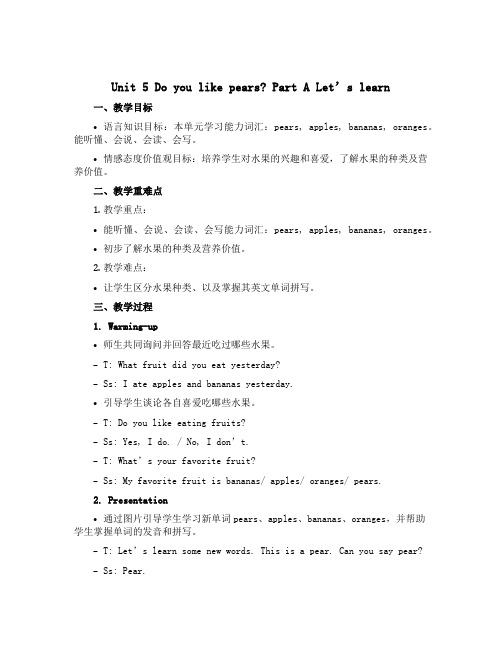
Unit 5 Do you like pears? Part A Let’s learn一、教学目标•语言知识目标:本单元学习能力词汇:pears, apples, bananas, oranges。
能听懂、会说、会读、会写。
•情感态度价值观目标:培养学生对水果的兴趣和喜爱,了解水果的种类及营养价值。
二、教学重难点1.教学重点:•能听懂、会说、会读、会写能力词汇:pears, apples, bananas, oranges。
•初步了解水果的种类及营养价值。
2.教学难点:•让学生区分水果种类、以及掌握其英文单词拼写。
三、教学过程1. Warming-up•师生共同询问并回答最近吃过哪些水果。
–T: What fruit did you eat yesterday?–Ss: I ate apples and bananas yesterday.•引导学生谈论各自喜爱吃哪些水果。
–T: Do you like eating fruits?–Ss: Yes, I do. / No, I don’t.–T: What’s your favorite fruit?–Ss: My favorite fruit is bananas/ apples/ oranges/ pears.2. Presentation•通过图片引导学生学习新单词pears、apples、bananas、oranges,并帮助学生掌握单词的发音和拼写。
–T: Let’s learn some new words. This is a pear. Can you say pear?–Ss: Pear.–T: This is an apple. Can you say apple?–Ss: Apple.–T: This is a banana. Can you say banana?–Ss: Banana。
–T: This is an orange. Can you say orange?–Ss: Orange。
新版PEP英语三年级下册说课稿 Unit5 Do you like pears
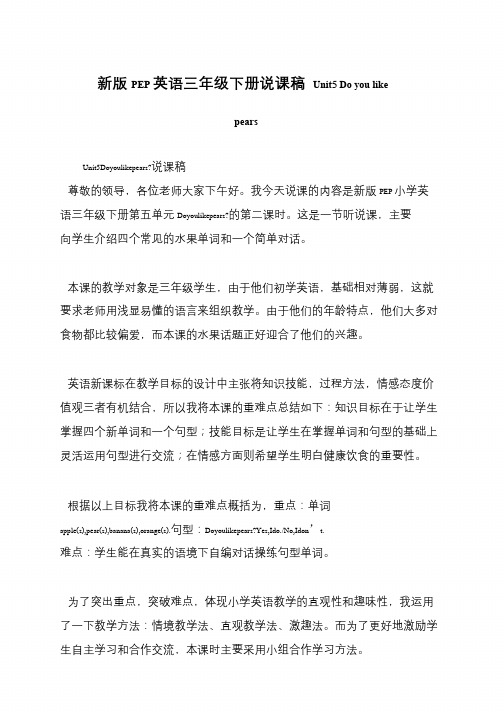
新版PEP 英语三年级下册说课稿Unit5 Do you like
pears
Unit5Doyoulikepears?说课稿
尊敬的领导,各位老师大家下午好。
我今天说课的内容是新版PEP 小学英
语三年级下册第五单元Doyoulikepears?的第二课时。
这是一节听说课,主要
向学生介绍四个常见的水果单词和一个简单对话。
本课的教学对象是三年级学生,由于他们初学英语,基础相对薄弱,这就
要求老师用浅显易懂的语言来组织教学。
由于他们的年龄特点,他们大多对
食物都比较偏爱,而本课的水果话题正好迎合了他们的兴趣。
英语新课标在教学目标的设计中主张将知识技能,过程方法,情感态度价
值观三者有机结合,所以我将本课的重难点总结如下:知识目标在于让学生
掌握四个新单词和一个句型;技能目标是让学生在掌握单词和句型的基础上
灵活运用句型进行交流;在情感方面则希望学生明白健康饮食的重要性。
根据以上目标我将本课的重难点概括为,重点:单词
apple(s),pear(s),banana(s),orange(s).句型:Doyoulikepears?Yes,Ido./No,Idon’t. 难点:学生能在真实的语境下自编对话操练句型单词。
为了突出重点,突破难点,体现小学英语教学的直观性和趣味性,我运用
了一下教学方法:情境教学法、直观教学法、激趣法。
而为了更好地激励学
生自主学习和合作交流,本课时主要采用小组合作学习方法。
人教PEP版英语三下《Unit 5 Do you like pears》说课稿设计
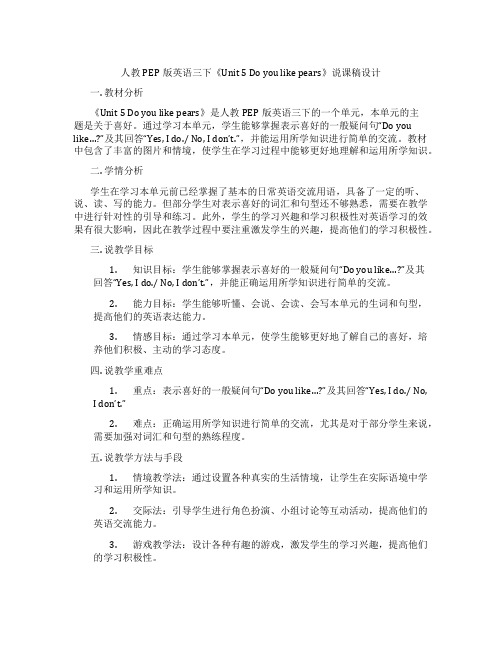
人教PEP版英语三下《Unit 5 Do you like pears》说课稿设计一. 教材分析《Unit 5 Do you like pears》是人教PEP版英语三下的一个单元,本单元的主题是关于喜好。
通过学习本单元,学生能够掌握表示喜好的一般疑问句“Do you like…?”及其回答“Yes, I do./ No, I don’t.”,并能运用所学知识进行简单的交流。
教材中包含了丰富的图片和情境,使学生在学习过程中能够更好地理解和运用所学知识。
二. 学情分析学生在学习本单元前已经掌握了基本的日常英语交流用语,具备了一定的听、说、读、写的能力。
但部分学生对表示喜好的词汇和句型还不够熟悉,需要在教学中进行针对性的引导和练习。
此外,学生的学习兴趣和学习积极性对英语学习的效果有很大影响,因此在教学过程中要注重激发学生的兴趣,提高他们的学习积极性。
三. 说教学目标1.知识目标:学生能够掌握表示喜好的一般疑问句“Do you like…?”及其回答“Yes, I do./ No, I don’t.”,并能正确运用所学知识进行简单的交流。
2.能力目标:学生能够听懂、会说、会读、会写本单元的生词和句型,提高他们的英语表达能力。
3.情感目标:通过学习本单元,使学生能够更好地了解自己的喜好,培养他们积极、主动的学习态度。
四. 说教学重难点1.重点:表示喜好的一般疑问句“Do you like…?”及其回答“Yes, I do./ No,I don’t.”2.难点:正确运用所学知识进行简单的交流,尤其是对于部分学生来说,需要加强对词汇和句型的熟练程度。
五. 说教学方法与手段1.情境教学法:通过设置各种真实的生活情境,让学生在实际语境中学习和运用所学知识。
2.交际法:引导学生进行角色扮演、小组讨论等互动活动,提高他们的英语交流能力。
3.游戏教学法:设计各种有趣的游戏,激发学生的学习兴趣,提高他们的学习积极性。
4.多媒体教学手段:利用多媒体课件、视频等资源,丰富教学内容,提高学生的学习效果。
do_you_like_pears说课稿

Do you like pears?说课稿南曲沟小学李彦一、说教材今天我要说课的内容是人教版教材三年级下册第5单元do you like pears?的第一课时,该部分主要是掌握四个有关水果的单词,分别是apple banana orange pear,和通过情景会话,让学生学习询问别人是否喜欢某种水果,并且在实际情景中自然运用。
二.说教学目标:1. 知识目标:能听,说,认读本课时水果单词: apple banana orangepear以及句型(Do you like …? Yes, I do.\No, I don’t. )2. 技能目标:培养学生运用英语进行交流的能力。
3. 情感目标:激发学生学习英语的兴趣,培养合作精神和爱吃水果的习惯。
三、说教学重、难点:教学重点:能听,说,认读本课时水果单词: apple banana orange pear 以及句型(Do you like …? Yes, I do.\No, I don’t. )教学难点:听懂、会说本课时句型, Do you like…?Yes, I do . \No,l don’t并能在实际情景中运用。
四、说教法学法:由于我教的是三年级的学生,根据儿童生理、心理特点及认识规律,要培养学生具有一定的语感和良好的语音、语调、以及书写基础,使他们具备用英语进行简单日常交流的能力。
我采用了直观法、情景法、游戏教学法等,在教学过程中创设生动活泼的语言环境,把学生吸引到活动中去,并激发他们主动参与学习的欲望。
不仅要使学生学会,更要使学生会学。
鼓励学生开口说,使学生在更轻松、更愉快的环境下,真正做到快快乐乐学英语,扎扎实实打基础。
五、说教学过程Step 1 Warm-up1.我通过对话Good morning, boys and girls! How are you ? Nice to meet you! 拉近师生之间的距离,营造宽松、和谐的课堂氛围,使师生均能以良好的精神状态进入课堂教学。
Unit 5 Do you like pears PB Let's learn 说课稿

Unit 5 Do you like pears PB Let’s learn 说课稿一、教学背景这一堂课是针对小学二年级学生,属于英语第一学期的第五单元教学内容,主要内容是学生学习关于食物喜好的表达方式,掌握部分食品的名称,能够描述自己的口味喜好,并培养学生的口语表达能力。
二、教学目标语言目标:1.能够理解、使用句型Do you like …? - Yes, I do. / No, I don’t.2.学会表达自己喜欢或不喜欢的食品,如I like bananas. I don’t like apples.3.掌握单词 pear, apple, banana, orange 等,并能识别其口音以及用法。
4.学会使用形容词描述食品的口感,如 sweet, sour, juicy。
能力目标:1.培养学生的口语交流能力。
2.提高学生对新单词的学习和记忆能力。
3.激发学生学习英语的兴趣和热情。
情感目标:1.让学生学会尊重他人口味和爱好。
2.培养学生的观察能力和判断力,学会选择健康的食品。
三、教学步骤1.导入(5分钟)上课前准备好展示一些果蔬的图片,并问学生这些食品是否喜欢吃,导入学习主题。
2.新知讲解(15分钟)通过玩游戏的形式介绍新单词和句型,比如说老师出示某种水果的图片,让学生表演出表达对这个食品喜好的句子。
3.练习(20分钟)让学生分为小组,进行交流,老师可在此环节给予学生帮助与指导。
比如引导学生使用正确的句型,扩展学生用形容词作进一步描述。
4.展示、评价学生表现(10分钟)引导学生向其他小组展示他们小组的交流内容,给予学生相应的反馈和鼓励。
5.巩固(5分钟)老师收集学生的表现以及学生交流的内容,形成课堂纪要,帮助学生复习课程内容。
四、教学重难点1.重点1.Do you like … ? 句型的用法。
2.如何正确表达自己喜不喜欢某种食品的意思。
2.难点1.如何用形容词描述食品口感以及口味。
五、板书设计1.板书内容Do you like … ?Yes, I do. No, I don’t.pear apple banana orangesweet sour juicy delicious2.板书布局板书在教学较大屏幕下出现,尽量使学生可以清晰易懂的看见。
人教版PEP三年级下册《Unit5Doyoulikepears》精品说课稿
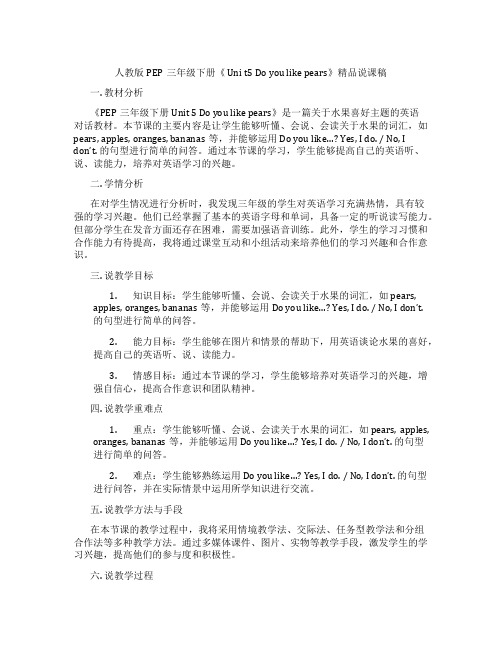
人教版PEP三年级下册《 Uni t5 Do you like pears》精品说课稿一. 教材分析《PEP三年级下册Unit 5 Do you like pears》是一篇关于水果喜好主题的英语对话教材。
本节课的主要内容是让学生能够听懂、会说、会读关于水果的词汇,如pears, apples, oranges, bananas等,并能够运用Do you like…? Yes, I do. / No, I don’t. 的句型进行简单的问答。
通过本节课的学习,学生能够提高自己的英语听、说、读能力,培养对英语学习的兴趣。
二. 学情分析在对学生情况进行分析时,我发现三年级的学生对英语学习充满热情,具有较强的学习兴趣。
他们已经掌握了基本的英语字母和单词,具备一定的听说读写能力。
但部分学生在发音方面还存在困难,需要加强语音训练。
此外,学生的学习习惯和合作能力有待提高,我将通过课堂互动和小组活动来培养他们的学习兴趣和合作意识。
三. 说教学目标1.知识目标:学生能够听懂、会说、会读关于水果的词汇,如pears,apples, oranges, bananas等,并能够运用Do you like…? Yes, I do. / No, I don’t.的句型进行简单的问答。
2.能力目标:学生能够在图片和情景的帮助下,用英语谈论水果的喜好,提高自己的英语听、说、读能力。
3.情感目标:通过本节课的学习,学生能够培养对英语学习的兴趣,增强自信心,提高合作意识和团队精神。
四. 说教学重难点1.重点:学生能够听懂、会说、会读关于水果的词汇,如pears, apples,oranges, bananas等,并能够运用Do you like…? Yes, I do. / No, I don’t. 的句型进行简单的问答。
2.难点:学生能够熟练运用Do you like…? Yes, I do. / No, I don’t. 的句型进行问答,并在实际情景中运用所学知识进行交流。
新PEP小学英语三年级下册Unit5Doyoulikepears说课稿[5篇]
![新PEP小学英语三年级下册Unit5Doyoulikepears说课稿[5篇]](https://img.taocdn.com/s3/m/8d3bd8bda1116c175f0e7cd184254b35effd1a40.png)
新PEP小学英语三年级下册Unit5Doyoulikepears说课稿[5篇]第一篇:新PEP小学英语三年级下册Unit5Do you like pears说课稿小学PEP英语三年级下册 Unit5《Do you like pears?》说课稿大家好,我说课的内容是《PEP小学英语》三年级下册第五单元第一课时。
本单元的话题是水果。
要求学生通过这一单元的学习,能够用英语表述常见的水果名称,简单描述对水果的喜好。
一、说教材。
本节课的教学目标:1.能听、说、认、读单词:banana、pear、apple、orange。
2.能听懂、会说句型Do you like…? Yes, I do./ No, I don’t。
并能在实际情境中运用。
3.能听懂、会说Let’s chant.教学重点:1.正确认读单词:pear, orange, apple, banana及其复数形式。
2.句型Do you like…? Yes, I do./ No, I don’t.教学难点:1.单词banana 的读音以及banana的复数形式的读法。
2.句型Do you like…? Yes, I do./ No, I don’t.的运用。
教具准备:水果图片和 PPT课件。
二、说学情:三年级的学生已经学了一学期的英语,英语功底还是很薄弱,我根据学生情况,以学生为主体,以激活他们对英语的兴趣为着入点。
因此在教学过程中应注重知识的反复操练和创设情境来激发学生学习英语的兴趣,让学生在乐中学。
三、说教法:根据学生的认知规律和教学内容的特点,我采用说唱歌谣法,创设情境法来激发学生的学习欲望,采用多媒体辅助法、词句相宜法教授新词,帮助学生建构英语语言体系。
四、说教学过程: 1.日常口语练习。
2.教授新词,词句相宜。
我利用白板的插入视频功能,插入水果歌谣动画视频,从而引出本课的内容。
在教授新单词时我创设了一个情境,并调出白板资源库中的图片来学习本课单词,并用智能笔很快画出四线格,在书写单词的同时,用录制功能把书写单词的过程录下来,重新播放一遍,让学生跟着一起书空。
Unit 5 Do you like pears? A Let’s spell( 说课稿)-2022
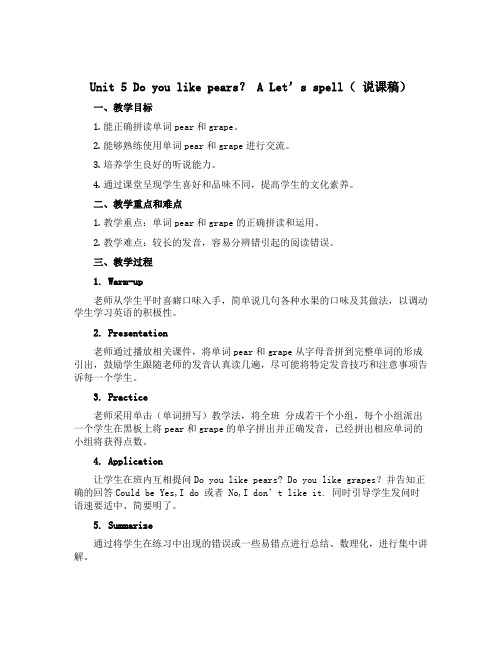
Unit 5 Do you like pears? A Let’s spell(说课稿)一、教学目标1.能正确拼读单词pear和grape。
2.能够熟练使用单词pear和grape进行交流。
3.培养学生良好的听说能力。
4.通过课堂呈现学生喜好和品味不同,提高学生的文化素养。
二、教学重点和难点1.教学重点:单词pear和grape的正确拼读和运用。
2.教学难点:较长的发音,容易分辨错引起的阅读错误。
三、教学过程1. Warm-up老师从学生平时喜癖口味入手,简单说几句各种水果的口味及其做法,以调动学生学习英语的积极性。
2. Presentation老师通过播放相关课件,将单词pear和grape从字母音拼到完整单词的形成引出,鼓励学生跟随老师的发音认真读几遍,尽可能将特定发音技巧和注意事项告诉每一个学生。
3. Practice老师采用单击(单词拼写)教学法,将全班分成若干个小组,每个小组派出一个学生在黑板上将pear和grape的单字拼出并正确发音,已经拼出相应单词的小组将获得点数。
4. Application让学生在班内互相提问Do you like pears? Do you like grapes?并告知正确的回答Could be Yes,I do 或者No,I don’t like it. 同时引导学生发问时语速要适中、简要明了。
5. Summarize通过将学生在练习中出现的错误或一些易错点进行总结、数理化,进行集中讲解。
6. Homework老师布置拍照寻找任意一个你觉得美味的水果,介绍它的味道、而售价,并告知各位班坐下赞同票数最多的三个同学。
四、教学评估教学中使用的方法简洁明了,具有针对性和实际性,学习效果明显,能较好地促进学生的学习兴趣和自主探究能力。
教学目标符合学生身心发展规律,考虑到学生英语学习的多样性,能够全面培养他们的听、说、读、写综合能力。
实施过程中,在教学重点难点解决过程中通过引导提问、互动交流等方式激发学生的兴趣,最大限度保证了教学效果。
Unit 5 Do you like pears?Part C(说课稿)-2022-2023学年英语
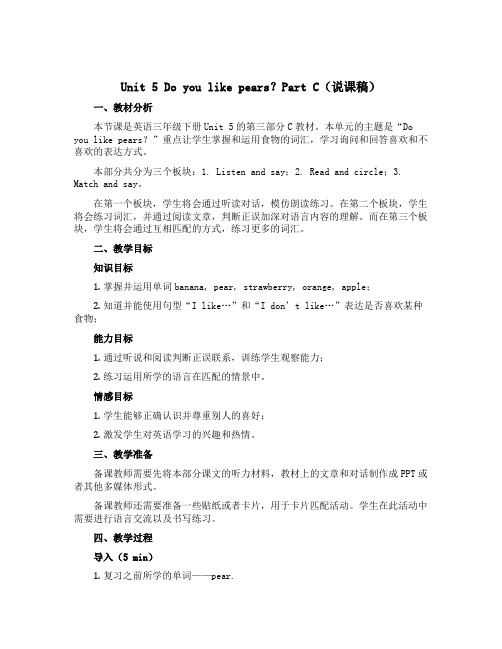
Unit 5 Do you like pears?Part C(说课稿)一、教材分析本节课是英语三年级下册Unit 5的第三部分C教材。
本单元的主题是“Do you like pears?”重点让学生掌握和运用食物的词汇,学习询问和回答喜欢和不喜欢的表达方式。
本部分共分为三个板块:1. Listen and say;2. Read and circle;3. Match and say。
在第一个板块,学生将会通过听读对话,模仿朗读练习。
在第二个板块,学生将会练习词汇,并通过阅读文章,判断正误加深对语言内容的理解。
而在第三个板块,学生将会通过互相匹配的方式,练习更多的词汇。
二、教学目标知识目标1.掌握并运用单词banana, pear, strawberry, orange, apple;2.知道并能使用句型“I like…”和“I don’t like…”表达是否喜欢某种食物;能力目标1.通过听说和阅读判断正误联系,训练学生观察能力;2.练习运用所学的语言在匹配的情景中。
情感目标1.学生能够正确认识并尊重别人的喜好;2.激发学生对英语学习的兴趣和热情。
三、教学准备备课教师需要先将本部分课文的听力材料,教材上的文章和对话制作成PPT或者其他多媒体形式。
备课教师还需要准备一些贴纸或者卡片,用于卡片匹配活动。
学生在此活动中需要进行语言交流以及书写练习。
四、教学过程导入(5 min)1.复习之前所学的单词——pear.2.与学生互动,问学生是否喜欢吃梨,创造一个简单的对话:Teacher: Do you like pears?Student: Yes, I do. /No, I don’t.学习内容(30 min)1.Listen and say教学人员播放录音,让学生跟读两遍,注意语言的语调和节奏。
2.Read and circle老师和学生一起阅读教材,通过圈出单词banana, pear, strawberry, orange, apple等练习词汇。
- 1、下载文档前请自行甄别文档内容的完整性,平台不提供额外的编辑、内容补充、找答案等附加服务。
- 2、"仅部分预览"的文档,不可在线预览部分如存在完整性等问题,可反馈申请退款(可完整预览的文档不适用该条件!)。
- 3、如文档侵犯您的权益,请联系客服反馈,我们会尽快为您处理(人工客服工作时间:9:00-18:30)。
Unit5 Do you like pears?Guanshan School Liu LuluGood afternoon, everyone!I am very glad to interpret my teaching design here. The topic of this lesson is “Do you like pears?”. There are four periods to finish this unit. I will talk about the first period. My presentation consists of the following parts.Part 1 Analysis of the teaching material1. Status and FunctionThis lesson is chosen from PEP English book, the second semester of grade3, Unit 5 “Do you like pears?” P art A Let’s learn. By using sentence "Do you like? Yes, I do. / No, I don’t” and four words “pear, apple, orange, banana" students will talk about their favorite fruits.2. Teaching aims and demandsKnowledge objects1) Students can read, understand and spell the English name of several fruits, such as, apple pear banana orange and understand the use of the plural forms.2) Can use the sentence pattern “D o you like…Yes, I do. / No, I don’t”.Ability Objects1)To improve the skills of speaking2)Encourage students to apply this knowledge into their daily life.Emotional objectsLet students improve their interest in learning English and understand fruit is very healthy to our body and foster the good habit of eating fruits everyday.3. Key points and DifficultyKey points: words—apple banana pear orangesentence structure —Do you like…Yes, I do. / No, I don’t Difficulty: understand the use of the plural formsPart 2 Analysis of the students.The students have just learnt English for a semester, so some of them don’t have many good learning methods. Some students dare not use English to express themselves. But they are curious, active and fond of game competition and various activities. They enjoy learning through cooperation in a relaxing atmosphere.Part 3 Teaching methods and Learning strategiesTeaching methodsIn this lesson, I will use directly method, that is to say, I will teach the key points by showing some pictures.In the process, I will apply blackboard, pictures and multi-media computer to arouse the students’ interestLearning strategies1)Speaking method2)Communicative strategy. Learn to cooperate with others. In class, encourage the students to communicate with others and build up their confidence.Part 4 Teaching AidsBlackboard, pictures, multi-media computerPart 5 Teaching Procedures.There are six steps in my teaching procedures.Step 1 Greeting and Lead-in.1.Make a free talk between T- S.2.Enjoy a radio. (Fruit Song)Purpose: Lead the students into the new lesson smoothly and arouse the students’ interest.Step 2 Let’s learn1. Presentation of the new words. (Play the PPT)T: Boys and girls, look at the screen. I have an orchard. There are some fruit. What are they?Let’s learn them.(1) Teach pear and pears.T: What’s this? (Show a picture of pear, the students may answer in Chinese. Then I show the word and write it on the blackboard. )T: Now read after me. pear ↗ pear↗ pear↘Ss: pear↗ pear↗ pear↘(Ask several students to read it.)T: Look! Now there are nine pears. pears ↗ pears↗ pears↘(Show a picture of nine pears, and lead students to understand the plural form.)(2) Teach apple 、orange 、 banana (use the same way)Purpose: make students master the four words and understand the use of the plural forms.2. Presentation of the sentence structureT:I like pears. Do you like pears?Yes, I do. / No, I don’t. (Show the sentences to the students and write them on the blackboard. Then lead students to read them. After that ask some students “ Do you like…”to practice this sentence pattern. ) Purpose: Let students be familiar with the sentence structure and speak out this structure without any thinking.Step 3 Practice1. Pair workGive students three minutes to use “D o you like…Yes, I do. / No, I don’t”to make a conversation with desk mates. Then I will invite some pairs to share their conversations with other students.Purpose: Develop students’ ability of communication and cooperation. By using the target language to consolidate the key structure and improve their speaking skills.2. Let’s play games1) What’s missing? (Make one kind of fruit missed quickly and ask students to speak out this fru it’s name quickly.)2)Guess!a. What’s this?b. RiddlesPurpose: Mobilize students' enthusiasm and initiative, in the same time, consolidate the key words.Step 4 Summary1. Summarize the words and the sentence structure.T: Look at the picture in the book, listen to the tape and read after the tape.(Play the tape and ask students to read after the tape)Purpose: Strengthen what they’ve learnt in this class.2.Enjoy a radioT: An apple a day keeps the doctor away, that means, eating more fruits can keep you healthy! Let’s eat t he fruits.Purpose: Make students understand fruit is very healthy to our body and foster the good habit of eating fruits everyday.Step 5 HomeworkDraw your favorite fruits and talk about in English.Purpose: Improve their speaking ability.Step 6 blackboard DesignUnit 5 Do you like pears?pear pears apple apples orange oranges banana bananasDo you like pears/ apples/ oranges/ bananas?Yes, I do.No, I don’t。
